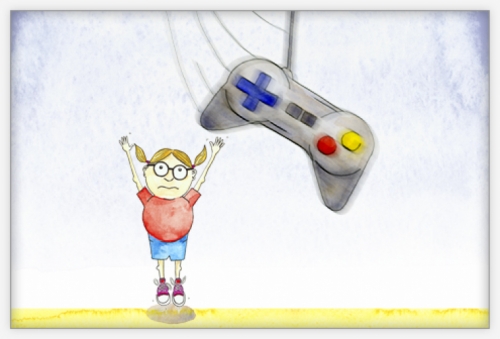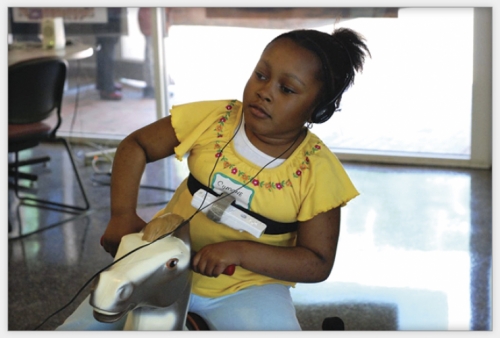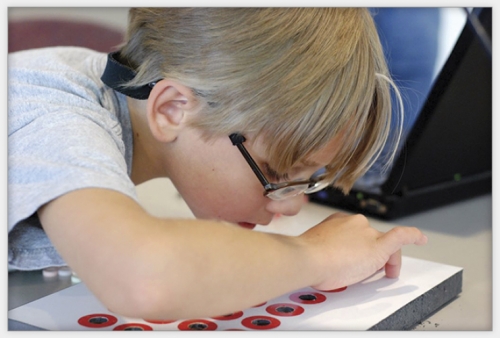A normally quiet corner of Sitterson Hall, home to UNC’s computer science department, is full of chatter today as kids and adults wait in a knot. In the middle of the floor, a slender girl with bright blond hair hops onto a plastic mat divided into nine squares.
A tune starts to play, and the girl moves her feet, first tentatively, then with more confidence as she learns to stomp on the squares in time to the beat. The projector screen in front of her displays an equally blond animated character doing dance moves with her upper body, smiling when the player correctly hits a beat.
The game sounds a lot like the dance video games that have been popular in the United States for nearly a decade. But there’s one major difference: the girl standing on the dance pad is blind. She can’t see her dancing counterpart on the screen in front of her — and she doesn’t really need to. The game gives her audio feedback on her performance: a handclap when she steps in time to the beat, an occasional buzzer when she’s off rhythm. Six-inch-wide pieces of carpet cover the centers of the squares on the pad, telling her feet where to step.
Like many of the other games on display nearby, Move to the Music includes visual effects to appeal to sighted players. But all the games were designed by student creators primarily for players who can’t see.
The students are getting lots of opportunities to test their work. Maze Day — named for a maze kids navigate by listening for the sounds of howling wolves and trumpeting elephants — has drawn seventy kids from around North Carolina, all of them visually impaired.
According to a November 2007 Associated Press-AOL Games report, 81 percent of children ages four to seventeen now play video or computer games at least occasionally. And the gaming sector is growing rapidly. Marketing research group NPD reported that Americans spent $17.9 billion on video games and consoles in 2007, up from $12.5 billion in 2006.
Players can get just about any kind of game they want, from sports to shooting games to online role-playing worlds with millions of characters. But the games all have something in common: you have to be able to see the screen in order to play.
It’s no mystery why so much more is available for sighted players than unsighted ones, says Gary Bishop, one of Maze Day’s organizers. “We’ve built this economy so that you can have whatever you want — as long as a million other people want it too.” That’s why Bishop has led an effort to attract UNC students to projects that make technology accessible to people with visual impairment and other disabilities.
There’s one trend in the gaming industry that may be hopeful for blind people: the recent popularity of games incorporating a physical dimension. In 2001 Dance Dance Revolution (DDR) became the first popular dancing game to come to home consoles. Since 2005, Guitar Hero — a game that cues players to press buttons on a guitar-shaped controller to simulate playing rock music — has become popular with both kids and adults. And in 2006, Nintendo’s Wii console with a detached controller opened up the possibility for a variety of games in which players shake, wave, and swing the controller to direct on-screen action.
None of these popular technologies were marketed to visually impaired players. But with practice, a visually impaired kid can stomp on a pad, swing a controller, or strum a guitar as well as a sighted one can.
Moving around while playing a video game may be even more helpful for blind kids than it is for sighted ones. “There aren’t as many things you can do when you come home from school, if you’re a blind kid,” Bishop says. “You’re not running around outside as much, you’re not playing basketball or riding bikes.”
Exercise was an important motivation for the students who adapted DDR for people with visual impairment. In the original game, directional arrows moving on the screen cue a player to step on the up, down, left, and right arrows on a dance pad. “The game is being put in schools now as a way to get exercise, but obviously blind kids can’t use it,” says Jason Cisarano, who worked on Move to the Music. “We wanted to make something blind kids could play, but that would also be fun to do with their classmates or siblings who can see.”
Another group of students also used DDR pads to help kids exercise, but with a different twist. Rather than following along with music provided by the game, players press DDR pads with their hands and feet to make their own music.
The game, called TechNote, was a semester project by three first-year students — Christy Sink, Chase Jenkins, and Bethany Jasper — who took a seminar with Bishop called Enabling Technology. “It turned out a couple of us had been big band geeks in high school,” Sink laughs. All three group members had at least rudimentary skill on the piano, so they got together one day and composed several cheery clips of melodies a few seconds long.
They linked the sounds to a DDR pad on the wall. Another pad on the floor linked to percussion sounds. “Visually impaired kids tend to have more problems with motor skills,” Sink explains. “With this game they’re moving their feet and pounding with their hands, so they get some upper body exercise as well.”
Other students used information readily available on the internet to write programs that can communicate with Nintendo’s Wii controller, called the Wii Remote or “Wiimote.” Given the task of making a sports game, one group picked a sport that would be familiar to their target audience: beep ball. The real-life game is based on baseball and played by many blind kids and adults, using a softball that beeps and bases that make buzzing sounds. The game the students created combines verbal cues such as “Ready!” “Pitch!” and “Strike!” with simple figures that seem to zoom closer to the player as they run across a green field. The player swings the Wiimote to hit the ball, then shakes the controller back and forth to run toward a base.
Another group’s cowboy-themed game attaches the Wiimote to a strap worn around the chest. Seated on a rocking horse or exercise ball, the player hears mooing cows, clucking chickens, and so on, and “catches” the animals for points by leaning right or left and bouncing up and down.
“We had to think about a theme all young kids would understand,” says computer science major Chris Barefoot. “Kids love animals, and whether they can see them or not, they all know the sounds that different animals make.”
Most of the games at Maze Day are based on widely available technology with few modifications. “It reflects the focus I have now on commodity hardware,” Bishop says. “If I make custom hardware, nobody’s going to have a copy. But if I use stuff you can buy off the shelf, it’ll be relatively inexpensive and lots of people will be able to use it.” A lot of the games at Maze Day use microphones or webcams that can be bought for about $15. Even the DDR-style games are made up of inexpensive gear, and the only modification is gluing on some squares of scrap carpet.
There are a few more expensive or more technical exceptions, such as the Wiimotes, which currently sell for about $40. Maze Day this year also included a blind-accessible guitar-playing game, developed by two students in Bishop’s first-year seminar. As in Guitar Hero, note cues on the screen appear to travel toward the player. The students’ innovation is in the guitar-shaped controller, which they modified to make buttons vibrate, first weakly, then more strongly to signal the player when to play a note.
Bishop’s goal, echoed by many of the students who worked on the accessible games, is to make most of their products freely available online, filling a niche that markets don’t.Many of the games were written in popular computer languages such as Python that are backed by powerful libraries of open-source programming tools. This allows other programmers to easily improve or build on each other’s products.
All the groups of students said they may continue to work on improving their games outside of class. Carl Schissler, one of Wii Beep Ball’s authors, plans to put the game on the open-source web site SourceForge. Kevin Coletta is working on a web site to advertise Move to the Music. He’s also trying to add an important feature: letting users import their own music files. The challenge is making a program that can reliably detect the beat of a tune, Coletta says.
For Bishop, who has organized Maze Day for four years, a major motivator is knowing that he and his students are in a relatively small pool of computer scientists working on such projects. This year their half-day event drew kids and teachers from as far away as Buncombe and New Hanover Counties. “We even had one teacher who was from Alabama,” Bishop says. “People are willing to come from so far away — it tells you something about how little there is out there for these kids.”
Gary Bishop is a professor of computer science in the College of Arts and Sciences. Zachary Swartz, who graduated in May 2008 with a BS in computer science, and Trey Brumley, a senior majoring in computer science, worked on Move to the Music. Carl Schissler is a junior majoring in computer science. Jon Latane, a senior computer science major, and Mitchell Rao, a May 2008 BS graduate in computer science, worked on Wii Beep Ball. May 2008 BS graduates in computer science John Batchelor and Daniel Parker and senior computer science major Michael Zachary worked on Rocking Horse. Maggie Stafford and Rhiannon Little, sophomores in the College of Arts and Sciences, developed the accessible Guitar Hero game. Kevin Coletta is a senior majoring in computer science.






